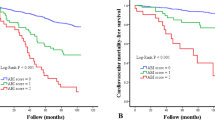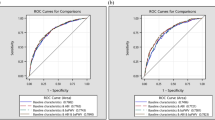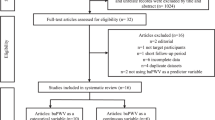Abstract
This study aimed to investigate the relationship of ankle–brachial index (ABI) with all-cause mortality and cardiovascular (CV) mortality in Chinese inpatients after 3 years of follow-up. All the participants were inpatients at high risk of atherosclerosis and enrolled from July to November 2004. A total of 3210 patients were followed up until an end point was reached or until February 2008. The mean follow-up time was 37.65±1.54 months. Patients with ABI ⩽0.4 were significantly older than other ABI categories (P<0.001) at baseline. The all-cause and CV disease (CVD) mortality were highest (37.7 and 27.5%, respectively) after a 3-year follow-up in patients with ABI ⩽0.4. There was a significant increasing tendency in mortality with decreasing ABI levels (P<0.001). The Kaplan–Meier curves of survival showed a decreasing survival rate with the ABI decreasing, not only for all-cause mortality but also for CVD mortality (P<0.001). Adjusted for other risk factors, patients with ABI ⩽0.4 were 3.105 times (95% CI 1.936–4.979) as likely to die as those with ABI in the range of 1.00–1.4; patients with ABI ⩽0.4 were about five times (95% CI 2.740–8.388) as likely to die of CVD as those with ABI in the range of 1.00–1.4. Even patients with ABI in the range of 0.41–0.90 were more than 1.5 times as likely to die (relative risk=1.534, 95% CI 1.199–1.962), or die of CVD (relative risk=2.031, 95% CI 1.479–2.789) as those with ABI in the range of 1.00–1.4. Low ABI is related to a higher all-cause and CV mortality compared with normal ABI. ABI as a marker of atherosclerosis should be routinely evaluated to assess the risk of CV mortality in Chinese patients.
This is a preview of subscription content, access via your institution
Access options
Subscribe to this journal
Receive 12 digital issues and online access to articles
$119.00 per year
only $9.92 per issue
Buy this article
- Purchase on Springer Link
- Instant access to full article PDF
Prices may be subject to local taxes which are calculated during checkout


Similar content being viewed by others
References
Newman AB, Siscovick DS, Manolio TA, Polak J, Fried LP, Borhani NO et al. Ankle–arm index as a marker of atherosclerosis in the Cardiovascular Health Study. Circulation 1993; 88: 837–845.
Zheng ZJ, Sharrett AR, Chambless LE, Rosamond WD, Nieto FJ, Sheps DS et al. Associations of ankle–brachial index with clinical coronary heart disease, stroke and preclinical carotid and popliteal atherosclerosis: the Atherosclerosis Risk in Communities (ARIC) Study. Atherosclerosis 1997; 131: 115–125.
Criqui MH, Denenberg JO, Langer RD, Fronek A . The epidemiology of peripheral arterial disease: importance of identifying the population at risk. Vasc Med 1997; 2: 221–226.
Fowkes FG . The measurement of atherosclerotic peripheral arterial disease in epidemiological surveys. Int J Epidemiol 1988; 17: 248–254.
Dieter RS, Chu WW, Pacanowski JP, McBride PE, Tanke TE . The significance of lower extremity peripheral arterial disease. Clin Cardiol 2002; 25: 3–10.
Newman AB, Sutton-Tyrrell K, Vogt MT, Kuller LH . Morbidity and mortality in hypertensive adults with a low ankle/arm blood pressure index. JAMA 1993; 270: 487–489.
Criqui MH, Langer RD, Fronek A, Feigelson HS, Klauber MR, McCann TJ et al. Mortality over a period of 10 years in patients with peripheral vascular disease. N Engl J Med 1992; 326: 381–386.
McKenna M, Wolfson S, Kuller L . The ratio of ankle and arm arterial pressure as an independent predictor of mortality. Atherosclerosis 1991; 87: 119–128.
Sikkink CJ, van Asten WN, van't Hof MA, van Langen H, van der Vliet JA . Decreased ankle/brachial indices in relation to morbidity and mortality in patients with peripheral arterial disease. Vasc Med 1997; 2: 169–173.
Hasimu B, Li J, Nakayama T, Yu J, Yang J, Li X et al. Ankle brachial index as a marker of atherosclerosis in chinese patients with high cardiovascular risk. Hypertens Res 2006; 1: 23–28.
Li X, Li J, Nguyen T, Zhao M, Zheng L, Hasimu B et al. Effect of statins and calcium channel blockers on all-cause mortality and cardiovascular and cerebrovascular disease mortality in 958 Chinese hospitalized patients with peripheral arterial disease after 13 months of follow-up. J Health Sci 2007; 53: 226–233.
Hirsch AT, Haskal ZJ, Hertzer NR, Bakal CW, Creager MA, Halperin JL et al. ACC/AHA 2005 Practice Guidelines for the management of patients with peripheral arterial disease (lower extremity, renal, mesenteric, and abdominal aortic): a collaborative report from the American Association for Vascular Surgery/Society for Vascular Surgery, Society for Cardiovascular Angiography and Interventions, Society for Vascular Medicine and Biology, Society of Interventional Radiology, and the ACC/AHA Task Force on Practice Guidelines (Writing Committee to Develop Guidelines for the Management of Patients With Peripheral Arterial Disease). Circulation 2006; 113: e463–e654.
Abbott RD, Petrovitch H, Rodriguez BL, Yano K, Schatz IJ, Popper JS et al. Ankle/brachial blood pressure in men over 70 years of age and the risk of coronary heart disease. Am J Cardiol 2000; 86: 280–284.
Resnick HE, Lindsay RS, McDermott MM, Devereux RB, Jones KL, Fabsitz RR et al. Relationship of high and low ankle brachial index to all-cause and cardiovascular disease mortality: the Strong Heart Study. Circulation 2004; 109: 733–739.
van der Meer IM, Bots ML, Hofman A, del Sol AI, van der Kuip DA, Witteman JC . Predictive value of noninvasive measures of atherosclerosis for incident myocardial infarction: the Rotterdam Study. Circulation 2004; 109: 1089–1094.
Newman AB, Shemanski L, Manolio TA, Cushman M, Mittelmark M, Polak JF et al. Ankle-arm index as a predictor of cardiovascular disease and mortality in the Cardiovascular Health Study. Arterioscler Thromb Vasc Biol 1999; 19: 538–545.
Vogt MT, McKenna M, Wolfson SK, Kuller LH . The relationship between ankle brachial index, other altherosclerotic disease, diabetes, smoking and mortality in older men and women. Atherosclerosis 1993; 101: 191–202.
Vogt MT, Cauley JA, Newman AB, Kuller LH, Hulley SB . Deceased ankle/arm blood pressure index and mortality in elderly women. JAMA 1993; 270: 465–469.
Leng GC, Fowkes FG, Lee AJ, Dunbar J, Housley E, Ruckly CV . Use of the ankle brachial pressure index to predict cardiovascular events and death. BMJ 1996; 313: 1440–1444.
Kuller LH, Shemanski L, Psaty BM, Borhani NO, Gardin J, Haan MN et al. Subclinical disease as an independent risk factor for cardiovascular disease. Circulation 1995; 92: 720–726.
Weatherley BD, Nelson JJ, Heiss G, Chambless LE, Sharrett AR, Nieto FJ et al. The association of the ankle–brachial index with incident coronary heart disease: the Atherosclerosis Risk In Communities (ARIC) study, 1987–2001. BMC Cardiovasc Disord 2007; 7: 3.
Ankle Brachial Index Collaboration. Fowkes FG, Murray GD, Butcher I, Heald CL, Lee RJ, Chambless LE et al. Ankle brachial index combined with Framingham Risk Score to predict cardiovascular events and mortality: a meta-analysis. JAMA 2008; 300: 197–208.
Graham I, Atar D, Borch-Johnsen K, Boysen G, Burell G, Cifkova R et al. European guidelines on cardiovascular disease prevention in clinical practice: full text: Fourth Joint Task Force of the European Society of Cardiology and other societies on cardiovascular disease prevention in clinical practice (constituted by representatives of nine societies and by invited experts). Eur Heart J 2007; 28: 2375–2414.
Acknowledgements
The study was sponsored by the Shanghai Educational Development Foundation.
Author information
Authors and Affiliations
Corresponding authors
Rights and permissions
About this article
Cite this article
Li, X., Luo, Y., Xu, Y. et al. Relationship of ankle–brachial index with all-cause mortality and cardiovascular mortality after a 3-year follow-up: the China ankle–brachial index cohort study. J Hum Hypertens 24, 111–116 (2010). https://doi.org/10.1038/jhh.2009.49
Received:
Revised:
Accepted:
Published:
Issue Date:
DOI: https://doi.org/10.1038/jhh.2009.49
Keywords
This article is cited by
-
Disparate effects of ankle-brachial index on mortality in the ‘very old’ and ‘younger old’ populations-the PolSenior survey
Heart and Vessels (2022)
-
Systematic Review of Association Between Low Ankle–Brachial Index and All-Cause Cardiovascular, or Non-cardiovascular Mortality
Cell Biochemistry and Biophysics (2015)



